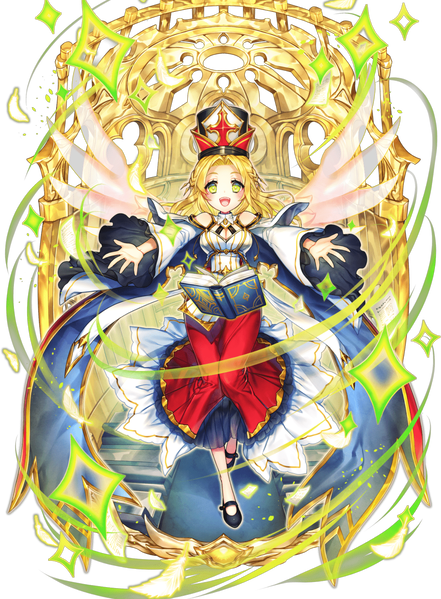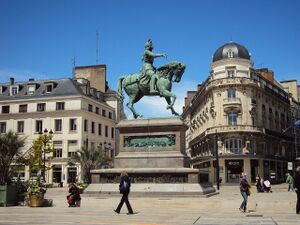Orleans
| Orleans | |||||
|---|---|---|---|---|---|
| Japanese Name | オルレアン | ||||
| Weapon | |||||
| Race | Elf | ||||
| Nationality | |||||
| Birthday | April 18 | ||||
| Constellation | Aries | ||||
| Talents | Singing, Playing the organ | ||||
| Likes | Hymns | ||||
| Dislikes | Large machines, Modern weapons | ||||
| Strengths | Being able to interact with people without any favoritism | ||||
| Weaknesses | Too religious to vibe well with soldiers | ||||
| Hobbies | Writing poems | ||||
I'm Orleans. She who hears the voice of the Saint of the Mist. La Pucelle - Saint of the Mist. I have inherited her power and will to become the next Saint of the Mist. All in order to put an end to the suffering in this world. Come, follow me. Let us fight together for a world of light.
Layers
| Icon | Title | Release Date | Where to Obtain |
|---|---|---|---|
| [Second Mist Saint] Orleans | 2021 August 30 (EN) | Premium Gacha | |
| [One Who Hears the Saint's Voice] Orleans | 2021 October 1 (EN) | [Saint of the Mist and the Statue From Another World] Event Reward | |
| [Angel of Mercy] Orleans | 2023 October 24 | [Arrogant Military Princess and the Purgatory Drunken Fist] Limited Gacha | |
| [Saint Leading to Victory] Orleans | 2021 October 1 (EN) | [Saint of the Mist and the Statue From Another World] Pick Up Gacha, Premium Gacha | |
| [Sacred Sound for the New Year] Orleans | 2022 January 1 | [New Year Hunt! Want to Catch a Tiger!] Limited Gacha |
Obtained Skills
Trivia
- Orleans's birthday is the date of the beatification of Joan of Arc by Pope Pius X in 1909.
- La Pucelle is the goddess that Orleans receive visions from, meaning "The Maiden" in French. "Maiden of Orléans" is a reference to Jeanne d'Arc, a heroine of France for her role in the siege of Orléans and the coronation of Charles VII of France.
- Orleans' problem with impostor syndrome (alongside her liking of poems) is a reference to the satirical poem, "The Maid of Orleans" by François-Marie Arouet, better known by his pen name, Voltaire.
- Orleans's liking of organs could be a reference the Grand Organ of Cathedral Saint-Croix, Orleans, built by the French organ builder Cavaillé-Coll in 1880. It is generally regarded as one of the most authentic Cavaillé-Coll organs in France, alongside Saint-Sulpice and Saint-Denis.
Counterpart
Orléans station (French: Gare d'Orléans) is a railway station serving the city Orléans, Loiret department, central France. It is situated on the Paris–Bordeaux railway. Gare d'Orléans is a terminus station of the French National Railway Company (SNCF), served by trains from the Interloire and TER Centre-Val de Loire networks.
The first Orléans station was transformed and enlarged in 1876 and 1880; it was destroyed in 1902. The second station was built by the PO company but it was badly damaged during the Second World War. It was demolished after the war and replaced by a third station which opened on May 2, 1965. This new station was integrated in 1988 into the Place d'Arc shopping center.
The station went through another rebuild between 2005 to 2007. The old station was demolished and a new passenger hall was designed by the architects of AREP (the SNCF's integrated design office), Jean-Marie Duthilleul and François Bonnefille. It is a double double wave structure where the roof is made of 80% aluminum and 20% glass. The frame in curved tubes was made by the ACML company of the Fayat Group. The hall is built of glass, metal and wood to house the sales offices and the meeting room.
The fourth version of Orléans station was opened on January 18, 2008. The railway connects were not finished at the time. From 2000 to 2011, it was served by Aqualys relations (Paris – Tours), and by a daily Intercités train to Lyon. Wikipedia
Place du Martroi is the main square in the city center of Orléans located in the department of Loiret in the Centre-Val de Loire region . In the square stands the equestrian statue of Joan of Arc. The name "Martroi" comes from the Latin Martyrium and designates the place where the condemned were executed. It is not known whether the name refers to the many executions that took place or to the old cemetery from the Gallo-Roman era. The equestrian statue of Joan of Arc was produced in 1855 by Denis Foyatier, with bas relief pedestal by Vital Dubray. It is noteworthy that this square, which stands on the former location of the Bannier city gate, did not exist during Joan's lifetime.
Joan of Arc (Jeanne d'Arc) is considered a heroine of France for her role in the siege of Orléans and the coronation of Charles VII of France during the Hundred Years' War against England. After successfully leading several French military actions, she was captured, handed over to English authorities, convicted as a heretic, and burnt at the stake in 1431. Twenty-five years later, her conviction was formally overturned. Nearly 500 years after her death, she was canonized as a saint by the Roman Catholic Church. Since her death, Joan has been popularly revered as a martyr. After the French Revolution she became a national symbol of France. She was canonized in 1920, and declared a secondary patron saint of France in 1922. Joan of Arc remains a popular figure in modern literature, painting, sculpture and music, and cultural depictions of her continue to be created.
The Fêtes de Jeanne d'Arc (Joan of Arc festival) in Orléans has been listed in the National Inventory of Intangible Cultural Heritage since 26 February 2018. This festival, which takes place from 29 April to 8 May, has been celebrated and embraced by the people of Orléans for almost 600 years. Wikipedia
Map
Gallery
- Pages using Tabber parser tag
- Pages using DynamicPageList3 parser tag
- Weapon Artifact
- Elf
- Verforet
- Aries
- Element Cut
- Element Light
- Train Knights
- France


















